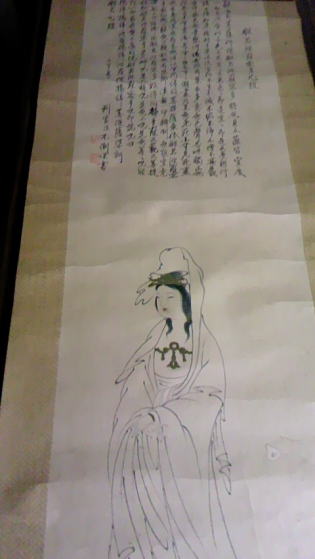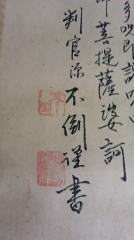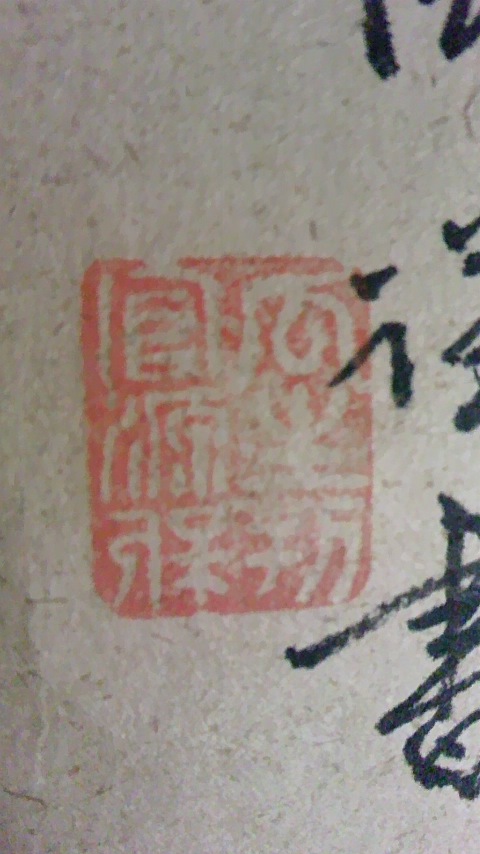お問合せ
事務局・工房くらし月
English top Concept Item list About us Contact
A name that came from 700 years ago
Uryu ( ?-1337)
This hanging scroll was found at a second-hand store in Fukuoka, 2017.
This scroll has Maka Hannya Haramitashin-gyo Sutra with an image of deity.
Who is Uryu Tamotsu or Minamoto Futo?
In Japan's historical epic "Taiheiki" written in the late 14th century,
the name of "Uryu Hangan Minamoto Tamotsu" appears as warrior
who had trouble deciding which side he should be, for Nitta or for
Ashikaga. He was once for Ashikaga side then returned to Nitta side.
In both sides many strategic alliances and intrigues were carried out.
All that was needed was to decide the true heir to the throne. Nitta
and Ashikaga were generals of each army led by two different
emperors.
In 1336, the Ashikaga force lost in the battle of Kyoto and fled to Kyushu.
At this point Ashikaga was still a rebel, so he decided to set up another
emperor. (The details are described in page 44, A HISTORY OF JAPAN
Volume2, 1979 by Sir George Sansom.
According to "Taiheiki", as Nitta had just fell in love with a lady, he did
not follow the Ashikaga force to Kyushu. It was Kikuchi that replaced
Nitta in Kyushu. Kikuchi was an excellent warlord. At this point no one
was expecting Ashikaga to eventually be the winner of the battle. And
we, who live in the 21st century, may not be able to understand the
reason why Ashikaga won.
At Tatarahama in Fukuoka , there was a battle in the spring, 1336.
The Ashikaga force was absolutely disadvantageous on the number.
The battlefield was the beach called Tatarahama, with five kilometers
white sand field and pine tree woods. When fighting, The wind blew
toward Kikuchi from the direction of Ashikaga. The Ashikaga force was
less than 1000 soldiers in all, and the enemy army is said to have
exceeded 30,000 soldiers including the Kikuchi force.
When the battle started, the sudden north wind blew and sand dust soared,
and the Kikuchi force could not open their eyes. The Kikuchi force was 5000
soldiers by the attack but it decreased to 3,000 soldiers and had to retreat
about 2 kilometers. Seeing that, warlords who turned to Ashikaga from
the enemy began one after another, and Ashikaga won at last.
It is said that it was "luck "by natural phenomenon that less than 1000
soldiers won more than 30,000 soldiers. People in those days may have
feared a gust of wind as mysterious power. Warlords and soldiers may not
have been exceptions. Today, there is no sand beach or pine tree woods
there. It is difficult for us to imagine the sudden gust at that time.
In fact there should have been many other factors in the outcome, but
it is worth noting that a gust of wind was written as a factor that
controlled the battle in the commentary books.
This battle at Tatarahama, which Ashikaga won, was a great stride for
Ashikaga for mastery of the whole country.
*******************************************.
What happened to Uryu?
As a result, this battle brought new battles. Nitta who stayed in Kyoto,
and the emperor whom Nita served, were surprised at the loss in
Kyushu. Nitta protected two princes of the emperor and fled north with
the princes.
They stayed at Kanegasaki Castle in Echizen (Tsuruga City, Fukui Prefecture).
Uryu was the castle lord of Somayama, who was in charge of supporting
the Nitta force.
The Uryu brothers were known for their bravery. They came from the
family line of Saga Genji. Japan's legendary hero, Watanabe no Tsuna,
who is famous for defeating demons in the 12th century, also came
from Saga Genji.
.
Both Nitta and Ashikaga had the same origin of Seiwa Genji. The
fact of the same origin or the same family line did not help. In
this battle of the 14th century, many were killed, some were poisoned,
and the people who lost the battle and survived cut their bellies for
honor and died. Just as all the battles are disastrous, this battle was
also miserable.
*****************
It is a mystery whether the paper scroll came from Uryu himself
in Taiheiki, or an utter stranger, or one of descendants named after
Tamotsu. Anyway a Uryu prayed and left the paper scroll. The polite
touch of his drawing conveys a feeling of his seriousness. And the
paper used by Uryu is mysteriously beautiful if it is 700 years old.
******************************************
The deity in the hanging scroll formed a ring with the thumb and the ring
finger of the right hand, and the left hand softly covers over it. The deity
stands without a Buddhist altar or pedestal, just with a neck ornament
and a head ornament, showing a frowning face. The year he created this
work is unknown. The date reads "Mid-summer Day".
**************************************************************
copyright: 2019 all reserved by the Toki Museum
t
A name that came from 700 years ago
 |
A name that came from 700 years ago The following sentence is cited from Sir George Sansom's A HISTORY OF JAPAN Volume2 , page 63-64, 1979, published by Charles E. Tuttle Company "If the liaison between Nitta and Uryu had been perfected, the two together might have made an impressive force, but they allowed the enemy to nibble at their strength and finally Uryu had to fall back on Somayama in the middle of March, 1337. " |
Uryu ( ?-1337)
This hanging scroll was found at a second-hand store in Fukuoka, 2017.
This scroll has Maka Hannya Haramitashin-gyo Sutra with an image of deity.
 |
Signature reads Hangan/Hogan Minamoto Futo. |
 |
The seal impression reads Uryu Hangan/Hogan Minamoto Tamotsu. |
Who is Uryu Tamotsu or Minamoto Futo?
In Japan's historical epic "Taiheiki" written in the late 14th century,
the name of "Uryu Hangan Minamoto Tamotsu" appears as warrior
who had trouble deciding which side he should be, for Nitta or for
Ashikaga. He was once for Ashikaga side then returned to Nitta side.
In both sides many strategic alliances and intrigues were carried out.
All that was needed was to decide the true heir to the throne. Nitta
and Ashikaga were generals of each army led by two different
emperors.
In 1336, the Ashikaga force lost in the battle of Kyoto and fled to Kyushu.
At this point Ashikaga was still a rebel, so he decided to set up another
emperor. (The details are described in page 44, A HISTORY OF JAPAN
Volume2, 1979 by Sir George Sansom.
According to "Taiheiki", as Nitta had just fell in love with a lady, he did
not follow the Ashikaga force to Kyushu. It was Kikuchi that replaced
Nitta in Kyushu. Kikuchi was an excellent warlord. At this point no one
was expecting Ashikaga to eventually be the winner of the battle. And
we, who live in the 21st century, may not be able to understand the
reason why Ashikaga won.
At Tatarahama in Fukuoka , there was a battle in the spring, 1336.
The Ashikaga force was absolutely disadvantageous on the number.
The battlefield was the beach called Tatarahama, with five kilometers
white sand field and pine tree woods. When fighting, The wind blew
toward Kikuchi from the direction of Ashikaga. The Ashikaga force was
less than 1000 soldiers in all, and the enemy army is said to have
exceeded 30,000 soldiers including the Kikuchi force.
When the battle started, the sudden north wind blew and sand dust soared,
and the Kikuchi force could not open their eyes. The Kikuchi force was 5000
soldiers by the attack but it decreased to 3,000 soldiers and had to retreat
about 2 kilometers. Seeing that, warlords who turned to Ashikaga from
the enemy began one after another, and Ashikaga won at last.
It is said that it was "luck "by natural phenomenon that less than 1000
soldiers won more than 30,000 soldiers. People in those days may have
feared a gust of wind as mysterious power. Warlords and soldiers may not
have been exceptions. Today, there is no sand beach or pine tree woods
there. It is difficult for us to imagine the sudden gust at that time.
In fact there should have been many other factors in the outcome, but
it is worth noting that a gust of wind was written as a factor that
controlled the battle in the commentary books.
This battle at Tatarahama, which Ashikaga won, was a great stride for
Ashikaga for mastery of the whole country.
*******************************************.
What happened to Uryu?
As a result, this battle brought new battles. Nitta who stayed in Kyoto,
and the emperor whom Nita served, were surprised at the loss in
Kyushu. Nitta protected two princes of the emperor and fled north with
the princes.
They stayed at Kanegasaki Castle in Echizen (Tsuruga City, Fukui Prefecture).
Uryu was the castle lord of Somayama, who was in charge of supporting
the Nitta force.
The Uryu brothers were known for their bravery. They came from the
family line of Saga Genji. Japan's legendary hero, Watanabe no Tsuna,
who is famous for defeating demons in the 12th century, also came
from Saga Genji.
.
Both Nitta and Ashikaga had the same origin of Seiwa Genji. The
fact of the same origin or the same family line did not help. In
this battle of the 14th century, many were killed, some were poisoned,
and the people who lost the battle and survived cut their bellies for
honor and died. Just as all the battles are disastrous, this battle was
also miserable.
*****************
It is a mystery whether the paper scroll came from Uryu himself
in Taiheiki, or an utter stranger, or one of descendants named after
Tamotsu. Anyway a Uryu prayed and left the paper scroll. The polite
touch of his drawing conveys a feeling of his seriousness. And the
paper used by Uryu is mysteriously beautiful if it is 700 years old.
******************************************
The deity in the hanging scroll formed a ring with the thumb and the ring
finger of the right hand, and the left hand softly covers over it. The deity
stands without a Buddhist altar or pedestal, just with a neck ornament
and a head ornament, showing a frowning face. The year he created this
work is unknown. The date reads "Mid-summer Day".
**************************************************************
copyright: 2019 all reserved by the Toki Museum
news
バナースペース
shop infoTHE TOKI MUSEUM
THE
TOKI
MUSEUM
PRIVACY POLICY
FACEBOOK
TWITTER
BLOG
JAPANESE
The Toki Museum
by
Atelier Classymoon